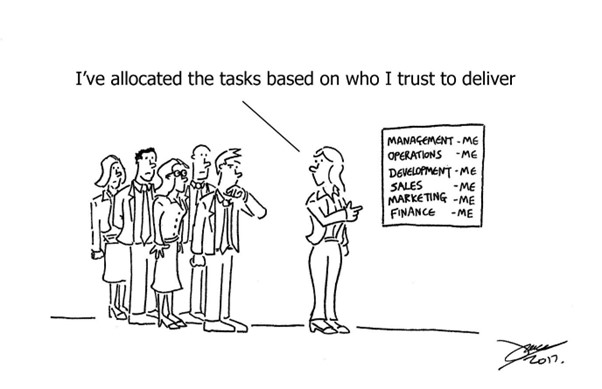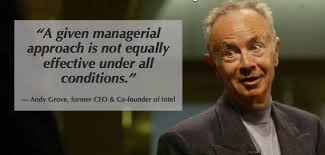- Have any questions?
- raju@ecselconsulting.com
The Eight-fold Path to Effective Delegation – Part 1
The Art of Win-Win Negotiation
The Eight-fold Path to Effective Delegation – Part 2 (Practical tips)
One of the most difficult transitions for new Managers to make is the shift from doing to leading. Many tenured managers too find it difficult to delegate work effectively, to their team members.

https://www.pod.eu.com/2017/10/16/delegate-or-disintegrate
The hardest part about delegating a task to someone else is trusting that they will do it well, or to one’s own standards and expectations. I can vividly recollect office scenes from several years back when, at just 22+ years of age, I started managing people formally for the first time.
After a few weeks, I had started feeling that if I wanted something done right, I had to do it myself. The reason – mismatch in perceptions and values relating to standards. Soon, my workload increased, I was coming in to work early and leaving the office very late, and I hurtled towards a burnout. I was lucky to have a boss (remembering the Late S.G. Diwadkar with gratitude) who taught me some of the basics of the art of delegation and rescued me.
As a new manager, perhaps initially, your seniors may be willing to overlook your tendency to hold on to work and sometimes, even admire your readiness to roll up your sleeves to carry out tactical assignments in a hands-on fashion. But, as your responsibilities increase and the expectations of seniors from you go up, you need to multiply your capacity and presence through the actions of others, engaging people so that they contribute their best work to the team’s shared priorities. The best managers are able to multiply their effectiveness through effective delegation skills.
A. Pause to gain another perspective
Mr. Diwadkar encouraged me to look at it like this…
1. If your team members are not given a chance to do the work themselves, how will they even have a chance to produce work that meets our standards and expectations?
2. True, it will take you less time to do this yourself vs. teaching someone else. But isn’t that self-sabotage, because one of your KPIs is to develop, groom and nurture people.
3. When people feel that they are trusted and respected, they tend to have a higher level of commitment to their work, their business unit, and their manager.
4. By systematically delegating tasks and developing people, you will have also groomed your successors. Remember the saying, if you can’t be replaced, you can’t be promoted!
It would seem I took his advice to heart and started implementing it, because I got promoted in about 12-15 months from then!
B. Other hurdles to ‘effective delegation’
Other usual reasons which come in the way of effective delegation include:
· You underestimate the capabilities of your team members, giving them fewer responsibilities than they can take on or you micro-manage them
· You overestimate the capabilities of your employees, giving them less guidance than they need
· You are insecure and don’t want your direct reports to outshine you
· You start to delegate but don’t tell the team what you’re doing and why
· You enjoy doing the work yourself
· You feel guilty about giving more work to an overworked staff
· You delegate but fail to take responsibility for the results – Delegation is certainly not equivalent to abdication or dumping unpleasant tasks on others
How many of these can you identify with?
C. Effective delegation through task-relevant maturity
You might have come across the concept of ‘task-relevant’ maturity of your team members, (Inspired by ‘High Output Management’ by Andy Grove) i.e. how long they have been on the job and how competent they are. This is closely linked to and helps determine your method of delegation.

- Low ‘task-relevant’ maturity means they are new and inexperienced in the job. In this case, he recommends using a directive delegation style. Tell people exactly what you want them to do.
- Medium ‘task-relevant’ maturity means staff has experience in the job; they know what they are doing. In this case, he recommends using the ‘management by objectives’ delegation method. Tell people the end result that you want and then get out of their way and let them do it.
- High ‘task-relevant’ maturity is when the staff person is completely experienced and competent. He recommends that in such cases, your method of delegation is simply, easy interaction.
This is similar to the situational leadership model whereby the manager assesses the developmental need of the team member and provides tailored supervision behavior.
D. Is there a magic recipe for effective delegation?
This is a good time to come up with a working definition for ‘Delegation’. Delegation is assigning responsibility and authority to someone in order to complete a clearly defined and agreed upon task, while you retain ultimate accountability for its success.
From my many years as a manager & leader and the last three years coaching others to manage and lead better, I’ve come to realise that a pre-requisite to effectively delegating work to team members and developing them is ‘Alignment before Assignment’.
“A good training rule of thumb is ‘I do, we do, you do’ (i.e. watch me do this, then let’s do it together, now you try),” says Cavoulacos, Founder of The Muse – i.e. Prior to the work assignment, the Manager should endeavor to structure the build-up of experience for the team members such that they are able to work their way up to a challenging task.
- Ideally (though not always possible, given high work pressures) the first time you introduce a task to someone, you might want them to experience it as a ride-along – let them shadow and observe someone senior.
- Then, give them a piece to do on their own with the senior’s supervision.
- Only let them carry the full load when you or the other senior feel that they are ready.
- Delegation is about finding & equipping people with the correct strengths and resources, and then launching them to accomplish the mission.
CPQQTRDF
You now agree that there will be major benefits all round if you delegate effectively, but how to get started?
There’s an easy-to-remember methodology – CPQQTRDF – that I share with my coaching clients, and they have found the framework very useful.
(I have borrowed the CPQ/QRT tool widely used for task assignment in a variety of industries and mentioned in Systems Leadership: Creating Positive Organisations, 2nd Ed, 2018 Ian Macdonald, Catherine Burke, Karl Stewart, and adapted it here.)
The Acronym stands for Context, Purpose, Quantity, Quality, Timelines, Resources & Restrictions, Dialogue and Feedback & Follow-up.
- One coaching client, a supply chain leader, had complained to me about his frustration with delegation – the frequent cases of poor quality of work and delayed completion whenever work was delegated. When I went through this framework with him and asked if anything here appealed to him, he picked C & P (Context & Purpose) as his key lessons, and put it in his Coaching Action Plan. Pleased to mention here that he reported after a month that he now was spending time upfront (10-15 minutes on an average) explaining the full context and purpose, resulting in better execution of the responsibilities assigned, less frustration for him and for the team members, as well as greater satisfaction among team members. Eventually, he saw how this could benefit in reducing his workload
- How often does it happen that a boss forwards an urgent email he or she receives onward to a direct report with a cryptic message- “Fix this”. What exactly does that mean? Managers must communicate their expectations unambiguously and make sure their direct reports understand them. This may mean specifying out by two dimensions as applicable: Quantity (how many units of output are needed?…), Quality (How well must it be completed? What parameters…?) Time (by when must it be completed…). Managers’ views are often biased by the reality that they are more capable and experienced than their direct reports and they may under-estimate the time and resources needed to complete the assignment or task.
- Another client found the D (Dialogue) as her a-ha moment, i.e. inviting questions and having a dialogue and not assuming that delegation is done once you have explained the task.
- And for a third, it was the follow-up skill which had been missing. Delegation won’t be complete without follow-ups & feedback.
My hope is that like these coaching clients, you too will have a chance to compare what you do now with the 8 elements of this framework and find some useful takeaways.
In Part 2, details about each of these elements and some suggestions on how to practically apply them.
